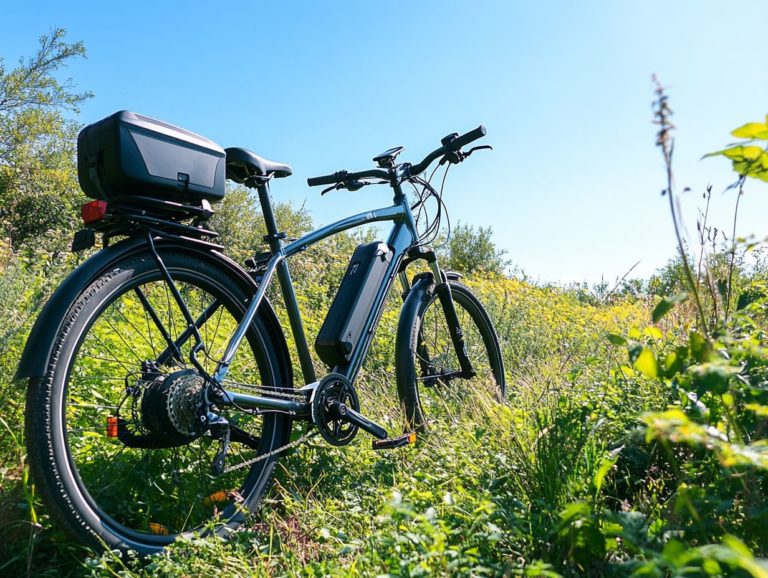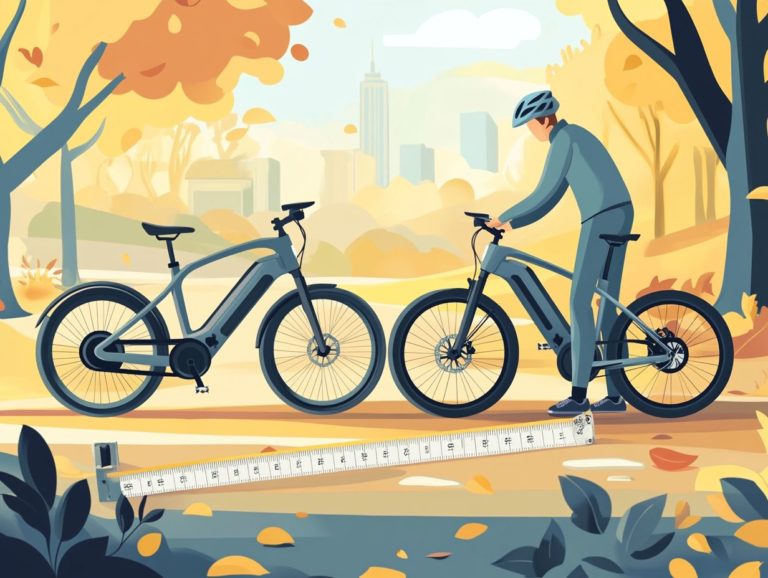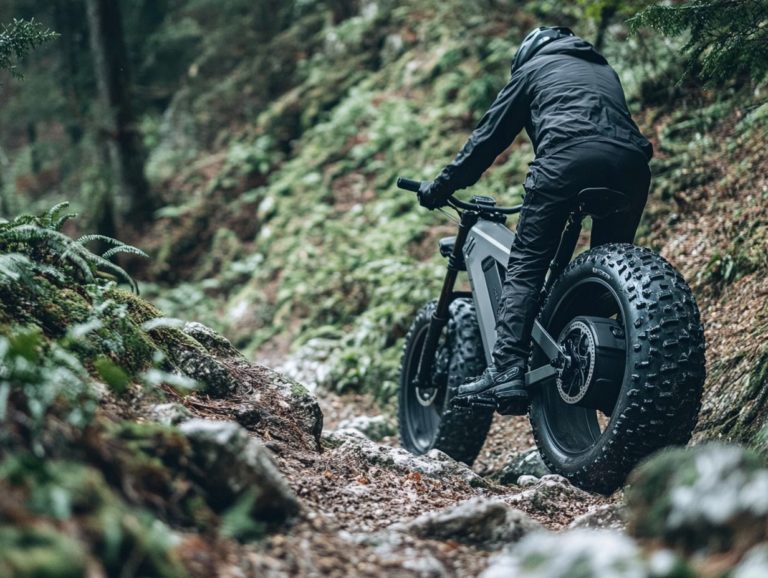How to Choose the Right Electric Bicycle for You
Electric bicycles are changing how we commute and enjoy leisure time. They blend the joy of cycling with the convenience of electric power.
Understanding the different types and features of electric bikes can be overwhelming. But this guide will help you navigate your options and find what suits you best.
Whether you ride casually or seek performance, you ll find insights that make your choice easier.
Contents
- Key Takeaways:
- Understanding Electric Bicycles
- Types of Electric Bicycles
- Factors to Consider when Choosing an Electric Bicycle
- Important Features to Look for in an Electric Bicycle
- Tips for Test Riding Electric Bicycles
- Maintenance and Care for Electric Bicycles
- Frequently Asked Questions
- What are the main factors to consider when choosing the right electric bicycle for you?
- Should I choose a pedal-assist or throttle-controlled electric bicycle?
- What is the ideal battery size for an electric bicycle?
- Do I need to consider the weight of the electric bicycle?
- What type of motor should I look for in an electric bicycle?
- Are there any legal considerations when choosing an electric bicycle?
Key Takeaways:

- Consider how you plan to use the bike and the terrain.
- Look for key features like battery life, motor power, and brakes.
- Test ride different models to feel their comfort and handling.
Understanding Electric Bicycles
Electric bicycles, or e-bikes, are a great step forward in personal transport. They integrate an electric motor to assist you while pedaling, making cycling more enjoyable for everyone.
E-bikes have several key components that improve your ride. A standout feature is the pedal assist, which helps based on how hard you pedal, making climbs easier.
Battery range is crucial, as it determines how far you can go on a charge. Knowing local laws regarding e-bike use is also important for your safety on the road.
These features promote a healthier lifestyle and make commuting and exploring truly exciting adventures.
Types of Electric Bicycles
Electric bicycles come in various types, each designed for different uses. This variety fits a wide range of preferences and riding styles.
You ll find class 1 e-bikes, which provide pedal assistance only, and class 3 models that allow for higher speeds without pedaling.
Classifying by Motor and Pedal Assistance
The main types of electric bicycles depend on their motor types hub motors and mid-drive motors and the level of pedal assistance they offer.
Hub motors are located in the wheel hubs and provide a quieter ride, perfect for easy commuting. Mid-drive motors are near the pedals, offering a natural feel and better hill-climbing performance.
Pedal assist technologies significantly affect your ride. Torque sensors adjust assistance based on your effort, while cadence sensors monitor your pedaling speed for a smooth experience.
Factors to Consider when Choosing an Electric Bicycle

When selecting an electric bicycle, consider several key factors that will enhance your riding experience. Think about your intended use, whether it’s leisurely rides or daily commutes.
Assess the comfort level while riding, as well as the bike’s ability to handle various terrains. Don’t overlook the weight capacity of the e-bike, as it can significantly impact your overall satisfaction and enjoyment on the road.
Each of these elements plays a crucial role in ensuring that your choice aligns perfectly with your lifestyle and riding preferences.
Intended Use and Terrain
The intended use of an electric bicycle greatly affects its design and features. Whether you’re gearing up for daily commuting, leisurely rides, or tackling rough trails like those for electric mountain bikes, understanding these factors is key.
Take a commuter bike, for example. It’s typically crafted for your comfort and efficiency on paved roads, focusing on lightweight frames and practical accessories like fenders and racks to carry your everyday essentials.
Hybrid e-bikes offer remarkable versatility, allowing you to transition effortlessly from bustling city streets to unpaved paths, catering to various environments and personal preferences.
Knowing how well your bike handles different terrains makes a big difference! Features such as tire width, suspension systems (which help absorb bumps in the road), and motor power are crucial in determining how well your e-bike can tackle obstacles and adapt to different surfaces. For more insights, consider choosing the right electric bicycle type for you to enhance your riding experience, especially for models like the Cannondale Compact Neo.
Budget and Features
When considering an electric bicycle, evaluate your budget alongside the features offered by various bike brands. These factors are key to determining the overall value and performance of your e-bike.
Establishing a well-defined budget will help you narrow down your options, but keep in mind that it also impacts the quality of components, battery life, and motor power.
Performance testing standards ensure the bike meets safety and efficiency metrics, giving you confidence as you ride. Warranty options are important; they not only protect your investment in the e-bike but also reflect the manufacturer s confidence in their product, which is essential for models like the Rad Power RadRunner.
Features like smooth gear shifts, comfortable seating, and robust braking systems can greatly enhance your riding experience. Therefore, it’s vital to strike a balance between cost and quality to find the perfect e-bike for your needs. To help with your decision, consider understanding different types of electric bicycles.
Important Features to Look for in an Electric Bicycle
When you re in the market for an electric bicycle, consider key features such as battery life, motor power, braking systems, and suspension types. Each of these elements plays a crucial role in enhancing overall performance and ensuring a comfortable ride.
For those interested in folding bikes for easy storage, this is especially important!
Battery Life and Range
Battery life and range are crucial factors for you when it comes to electric bicycles. They directly influence how far you can travel on a single charge and the quality of your overall riding experience.
Several elements come into play here, such as battery capacity, which determines the total energy your bike can store, and charging speed, which dictates how quickly you can recharge for your next adventure. Your riding style, the terrain you traverse, and even the weather can all affect battery performance.
To maximize your battery life during rides, maintain a steady pace and avoid sudden accelerations. Regularly check your tire pressure properly inflated tires can reduce drag and enhance efficiency. Keeping your bike clean and well-maintained will further boost its performance, allowing you to cover longer distances on each charge.
Motor Power and Speed

The motor power of an electric bicycle is a key factor that determines speed and overall performance. It directly influences how smoothly you can handle various terrains.
When assessing an e-bike’s capabilities, examine different levels of motor power. This power delivers the necessary torque the force that helps the bike start moving and climb hills and acceleration for better performance on steep inclines or uneven surfaces.
A higher wattage motor provides quicker starts and better speed maintenance. It s an excellent choice for bustling urban environments or exhilarating off-road adventures.
Engaging in performance testing practices, such as hill climb tests and speed trials, lets you evaluate not only the bike’s raw power but also its battery efficiency and range under diverse conditions. Understanding these elements can significantly elevate your riding experience.
Choosing the Right Brakes and Suspension for Your Ride
When selecting an e-bike, consider the quality of the braking systems and suspension types to improve riding comfort.
Effective brakes and high-quality suspension systems are vital for ensuring your safety and enhancing comfort while riding. This is especially important when handling various terrains.
Different braking systems, like disc brakes and rim brakes, offer varying levels of responsiveness and durability. Disc brakes are often preferred for their exceptional stopping power, particularly in wet conditions.
Suspension systems such as front suspension forks or full suspension setups absorb shocks from bumps and potholes, keeping your ride smooth. By understanding available options, you can choose the right setup that caters to your needs, improving both safety and enjoyment on every journey.
Tips for Test Riding Electric Bicycles
Test riding electric bicycles is an essential part of your purchasing journey. It gives you the chance to assess riding comfort, understand motor placement, and experience the overall handling firsthand.
What to Pay Attention to
When you set out to test ride an electric bicycle, immerse yourself in the experience. Pay attention to how comfortable you feel and the responsiveness of the motor.
Observe how the bike navigates various terrains whether it s gliding over smooth pavements, bumping across cobblestones, or tackling steep inclines. Each surface can dramatically influence your ride. Comfort is paramount for longer excursions, so evaluate the seat s cushioning and support as you journey through different routes.
Assess the ease of braking and acceleration and the intuitiveness of the control panels for managing the bike s settings. Observing how the bike interacts with environmental features like wind or incline will deepen your understanding of its capabilities and limitations.
Maintenance and Care for Electric Bicycles
Proper maintenance and care are essential for ensuring the longevity, performance, and safety of electric bicycles. This involves regular servicing, adhering to proper charging practices, and using high-quality materials in their construction.
By prioritizing these aspects, you can maximize the lifespan and efficiency of your electric bike. If you’re considering which type to choose for your adventures, check out city vs. mountain electric bicycles. This allows you to enjoy every ride with peace of mind.
Proper Charging and Storage

Properly charging and storing your electric bicycle’s battery is essential for maximizing its capacity and ensuring a longer range during your rides.
Investing a little time to understand some recommended practices can significantly enhance your battery’s performance. Charge the battery at moderate temperatures, ideally between 20 C to 25 C (68 F to 77 F). Extreme cold or heat can lead to damage, and nobody wants that!
Avoid fully depleting the battery before charging, as this can harm its longevity. Instead, aim to recharge it when it reaches about 20-30% of its capacity.
For storage, keep the battery at around 50% charge in a cool, dry place. This prevents prolonged exposure to low charge levels, which can wear down the battery cells over time. Taking these steps helps you enjoy every ride to the fullest.
Frequently Asked Questions
What are the main factors to consider when choosing the right electric bicycle for you?
Some of the most important factors to consider are your riding style, budget, terrain, and desired features.
Should I choose a pedal-assist or throttle-controlled electric bicycle?
It depends on your preference and needs. Pedal-assist bikes provide assistance while you pedal, while throttle-controlled bikes allow you to control the speed with a throttle.
What is the ideal battery size for an electric bicycle?
The ideal battery size depends on your riding needs. If you plan to ride long distances or on steep terrain, a larger battery size would be beneficial.
Do I need to consider the weight of the electric bicycle?
Yes, the weight of the bike can affect its performance and handling. If you plan to transport the bike frequently or have limited physical strength, consider a lighter option.
What type of motor should I look for in an electric bicycle?
There are different types of motors, including hub motors and mid-drive motors. Hub motors are generally more affordable and easier to maintain, while mid-drive motors provide a more natural riding experience.
Are there any legal considerations when choosing an electric bicycle?
Yes, laws and regulations regarding electric bicycles vary by state and country. Make sure to check the laws in your area to avoid surprises when you purchase your electric bike!






